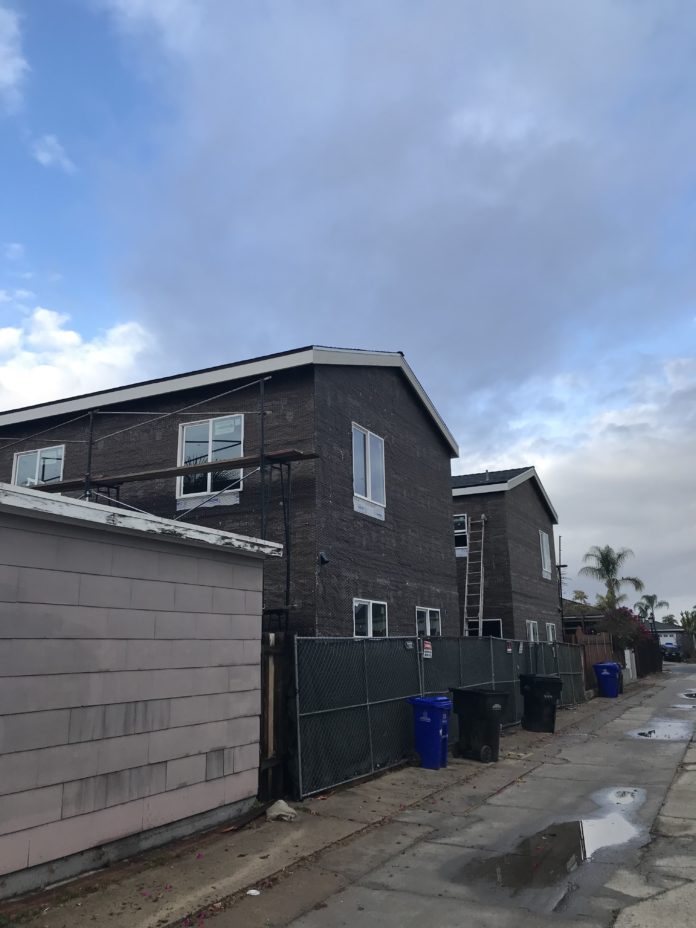Affordable Housing at What Cost
by Paul Krueger
A new definition of “affordable housing”: $2,000 monthly rent for a 480 square-foot, one- bedroom, one-bathroom ADU. Building industry consultant admits it’s “absurd, from the stand-point of affordability”
The permit application for a multi-unit rental complex on a single-family lot confirms that two of the apartments will be reserved for an affordable rental program administered by the San Diego Housing Commission.
In return for that set-aside, the city gave the developer a two-unit “bonus.” Instead of building just four units, he and his investors can cram a total of six rental units on this average-size residential lot in San Diego’s Talmadge neighborhood. Plus, the city’s controversial “Accessory Dwelling Unit” ordinance gives all absentee landlords and their investment partners additional perks not available on other apartment projects.
- They are exempt from the infrastructure fees required for other developments. Those fees help maintain city streets, sidewalks, sewer and water lines, parks, and other basic requirements of urban life.
- They don’t have to provide any off-street parking for tenants, even though the closest bus or trolley line might be three miles away. They don’t have to provide any incentives for mass transit use, or any disincentives to vehicle ownership.
- They can clear-cut the back and side yards, without replacing any lost landscaping, in direct conflict with the city’s Climate Action Plan and Urban Forestry Program.
- They can build multiple, multi -story rental units right up to the neighbor’s property line, with second-story windows that look directly into neighbors’ homes and backyards.
The developer of the Talmadge project is taking advantage of all those giveaways. And he’s giving nothing in return to low-income renters. That’s because the city’s restricted rent program allows him to charge top dollar for those apartments.
In a recent presentation to the North Park Planning Committee, a consultant for that project confirmed that the one-bedroom, one-bath backyard apartments — including the two “rent restricted” units — are expected to rent for $2,000 each. “I agree that’s absurd from the standpoint of an affordability perspective,” the consultant admitted.
It’s also evidence of the total failure of the city’s ADU policy, enshrined in an October 2020 ordinance that city staff falsely claimed was simply bringing San Diego into compliance with state regulations.
Instead of boosting the city’s anemic inventory of much needed very-low and low-income rentals, the ADU ordinance has produced only market-rate — and above-market-rate — housing. (The average monthly rent for a one-bedroom apartment is $1,823, as of August 2021, according to the market research firm Co-Star.)
But San Diegans searching for real solutions to our housing problem now have the power to help rewrite this ill-conceived, regressive ordinance.
On Thursday, December 16 city planning commissioners considered proposed amendments to the ADU codes. Neighbors For A Better San Diego (NFABSD) had identified a number of changes that would require developers to pay their fair share when building multi-unit projects. These proposed amendments also protect and preserve established neighborhoods while maintaining incentives, discounts, and streamlined approvals for homeowners who want to build a backyard “granny flat” and, if they choose, also convert their garage to an additional living unit.
NFABSD had prepared a tip sheet with talking points to share with the commissioners via Zoom, during the public comment portion of their meeting. Research had confirmed that many San Diegans strongly support and endorse the following restrictions:
- Limit ADU development to what the state requires: one Accessory Dwelling Unit (ADU) and one Junior Accessory Dwelling Unit (JADU) on single-family lots in residential neighborhoods. The so-called “Bonus ADU” program benefits only developers, not homeowners or other residents.
- Limit building height to 16-feet. ADUs are by definition “accessory” units, and should not tower over existing homes.
- Require four-foot minimum rear and side yard setbacks, to comply with state guidelines. By allowing “zero” setbacks, the city has increased fire risk and made firefighting more dangerous.
- Collect Development Impact Fees from property investors and developers. Our aging neighborhoods were not designed for high-density and do not have the infrastructure to support multi-unit ADUs.
- Protect our urban tree canopy and fight climate change by requiring developers to replace the shade trees and landscaping they destroyed to make room for multi-unit dwellings.
However, for those who participated in the Zoom meeting, the commissioners denied all of the proposed options, except they opted to add in the “additional tree request.”
“This disappointing result has not shaken our confidence, and we’re confident that common sense and good community planning will prevail when the City Council’s Land Use committee and the full council discuss the issue early next year. Your input at those public hearings are crucially important, and will make a difference. Keep current by joining our mailing list at www.nfabsd.org.”
Paul Krueger is a Talmadge resident and volunteer with Neighbors For A Better San Diego. You can learn more about the effort to sensibly rewrite our city’s destructive ADU regulations at www.nfabsd.org.

Category: Architecture, Featured Articles, Finance, Government, Housing, Local News, Politics







